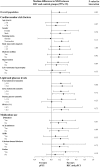Impact of cardiovascular risk factors and medication use on the efficacy of remote ischaemic conditioning: post hoc subgroup analysis of a randomised controlled trial
- PMID: 25838505
- PMCID: PMC4390720
- DOI: 10.1136/bmjopen-2014-006923
Impact of cardiovascular risk factors and medication use on the efficacy of remote ischaemic conditioning: post hoc subgroup analysis of a randomised controlled trial
Abstract
Objectives: Remote ischaemic conditioning (RIC) promotes cardioprotection in patients undergoing primary percutaneous coronary intervention (pPCI) for ST-elevation myocardial infarction (STEMI). The effect of RIC may be modified by cardiovascular risk factors and their medications. We examined whether cardiovascular risk factors, lipid and glucose levels, and medication use influenced the efficacy of RIC in patients with STEMI treated with pPCI.
Design: Post hoc subgroup analysis of a single-centre randomised controlled trial.
Participants: A total of 139 patients with STEMI, randomised during ambulance transport to hospital for pPCI with (n=71) or without (n=68) RIC, met the trial criteria and achieved data for a myocardial salvage index (MSI).
Interventions: RIC was administered through intermittent arm ischaemia with four cycles of 5 min inflation and 5 min deflation of a blood pressure cuff.
Primary outcome measures: MSI, estimated by single-photon emission CT. We evaluated the efficacy of RIC on the MSI in patient subgroups of cardiovascular risk factors, lipid and glucose levels, and medication use.
Results: We found no significant difference in the efficacy of RIC in subgroups of cardiovascular risk factors, lipid and glucose levels, and medication use. However, point estimates indicated a reduced effect of RIC among smokers (median difference in MSI between RIC and control groups: -0.02 (95% CI -0.32 to 0.28) in smokers vs 0.25 (95% CI 0.08 to 0.42) in non-smokers, p value for interaction=0.13) and an increased effect of RIC in statin users (median difference in MSI between RIC and control groups: 0.34 (95% CI 0.03 to 0.65) in statin users vs 0.09 (95% CI -0.11 to 0.29) in non-statin users, p value for interaction=0.19).
Conclusions: RIC as an adjunct to pPCI seems to improve MSI in our trial population of patients with STEMI regardless of most cardiovascular risk factors and their medications. Our post hoc finding on a limited sample size calls for further investigation in large-scale multicentre trials.
Trial registration number: NCT00435266.
Published by the BMJ Publishing Group Limited. For permission to use (where not already granted under a licence) please go to http://group.bmj.com/group/rights-licensing/permissions.
Figures


References
Publication types
MeSH terms
Substances
Associated data
LinkOut - more resources
Full Text Sources
Other Literature Sources
Medical
Miscellaneous
